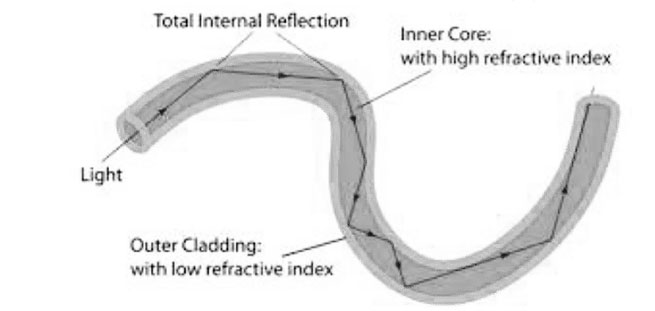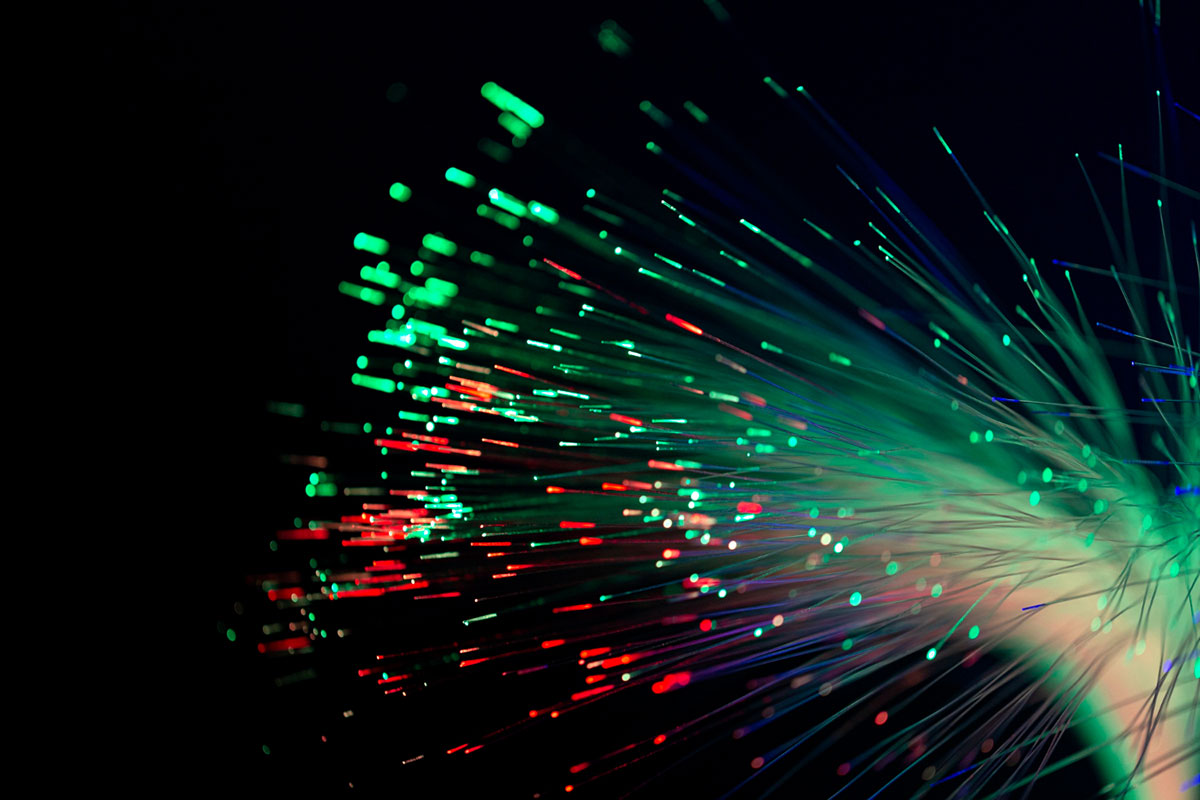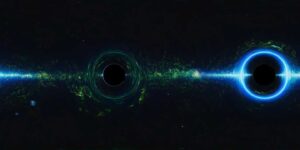Optical fiber these days have become a major source for the transmission of internet as it is capable of huge data transfer utilizing light in a very short time interval.
Since optical frequencies are extremely large (- 1015 Hz), as compared to the conventional radio waves (- 106 Hz) and microwaves (- 1010 Hz), a light beam acting as a carrier wave is capable of carrying far more information than radio waves and microwaves. It is expected that is the not too distant future, the demand for flow of information traffic will be so high that only a light wave will be able to cope with it.
Soon after the discovery of the laser, some preliminary experiments on propagation of information carrying light waves through the open atmosphere were carried out, but it was realized that because of the vagaries of the terrestrial atmosphere, e.g. rain, fog, etc., in order to have an efficient and dependable communication system, one would require a guiding medium in which the information carrying light waves could be transmitted. This guiding medium is the optical fiber which is a hair-thin structure and guides the light beam from one place to another.
In addition to the capability of carrying a huge amount of information, fibers fabricated with recently developed technology are characterized by extremely low losses (~0.2 dB/km) as a consequence of which the distance between two consecutive repeaters (used for revamping the attenuated signals) could be as large as 250 km.
In a recently developed fiber optic system, it has been possible to send 140 Mbit/s information through a 220 km link of one optical fiber; this is equivalent to about 450,000 voice channel-km. In comparison, copper cables used today have repeater spacings every few kilometers or so. Typical losses in various guiding media are shown in picture.
We should point out here that it is only recently that the devices used in fiber optic communication systems have become very reliable. Also, it has not been very long since the cost of the system came down considerably, enabling people through out the world to seriously begin the switch-over from copper cables to fiber optic systems. Indeed, the British Telecom in 1984 stopped laying copper wires on its long-distance routes· and sta1’ted using optical fibers.
In addition to long-distance communication systems, optical fibers are also being extensively used for local area networks (LANS)-networks that wire up telephones, televisions, computers or robots in offices and cities.

Just have a look at this picture. A glass fiber consisting of a (cylindrical) central core cladded by a material of slightly lower refractive index. The corresponding refractive index distribution (in the transverse direction) is given by
n(r) = n1 0 < r < a core
= n2 r > a cladding

and has been shown in second figure. Typically, n1 is approximately equal to 1.48, n2 is approximately equal to 1.46, and a is approximately equal to 50 μm. Now, for a ray entering the fiber, if the angle of incidence (at the core-cladding interface) ratio is greater than the critical angle (sin–1n2/n1), then the ray will undergo total internal reflection at that interface.
Further, because of the cylindrical symmetry in the fiber structure, this ray will suffer total internal reflection at the lower interface also and therefore, get guided through the core by repeated total internal reflections. Even for a bent fiber, light guidance can occur through multiple total internal reflections. The picture shows the actual guidance of a light beam as it propagates through a long optical fiber.

We should mention that the phenomenon of guidance by multiple total internal reflections were demonstrated by John Tyndall in 1854. In this demonstration, Tyndall showed that light travels along the curved path of water emanating from an illuminated vessel. However, fiber optics really developed in the 50’s with the works of Hopkins and Kapany in UK, and of Van Heel in Holland; these works led to the use of the fiber in optical devices.
The necessity of a cladded fiber rather than a bare fiber was felt because of the fact that for transmission of light from one place to another, the fiber must be supported, and supporting structures may considerably distort the fiber thereby affecting the guidance of the light wave. This can be avoided by choosing a sufficiently thick cladding. Further, in a fiber bundle, in the absence of the cladding, light can leak through from one fiber to another.
It is of interest to mention that the retina of the human eye consists of a large number of rods and cones which have the same kind of structure as the optical fiber, i.e. they consist of dielectric cylindrical rods surrounded by another dielectric of slightly lower refractive index. The core diameters are in the range of a few microns. The light absorbed in these “light guides” generates electrical signals which are then transmitted to the brain through various nerves.
One of the most important applications of the optical fiber is in the field of communications. We are all familiar with the fact that TV transmission utilizes VHF/UHF (very/ultra-high frequency ~ 30-3000 MHz) waveband while the normal radio broadcasts (voice and music) utilize lower frequencies (~300 kHz-30 MHz) of the electromagnetic spectrum.
The reason for this is that the information content of TV signals is much more compared to that of radio broadcasts, and TV signals cannot be sent intelligibly by using radio frequencies as the carrier. Indeed, the higher one goes up in the electromagnetic spectrum in the frequency scale, the higher would be the information carrying capacity of such a communications system.
That is why historically the trend in carrier wave communication (e.g. radio) has been always towards higher and higher frequencies because only by such means can the rate of handling and transmission of information be increased efficiently. Since optical beams have frequencies in the range of 1014 1015 Hz, the use of such beams as the carrier would imply a tremendously large increase in the information transmission capacity of the system as compared to the conventional systems of today.
In fact, the idea of using light waves for communication can be traced to as far back as 1880 when Graham Bell invented the photophone. In this remarkable experiment, speech was transmitted by modulating a light beam which travelled through air to the receiver.
The transmitter consisted of a diaphragm on which light from a source was concentrated and which could reflect light through a lens on a parabolic reflector placed at a distance. The parabolic reflector concentrates the light on a selenium cell which forms a part of a circuit with a battery and a receiving telephone.
Sound waves present in the vicinity of the diaphragm vibrate the diaphragm which leads to a consequent variation of the light reflected by the diaphragm. The variation of the light falling on the selenium cell changes the electrical conductivity of the cell which in turn changes the current in the electrical circuit. This changing current reproduces the sound on the telephone.

The modern impetus for telecommunications with carrier waves at optical frequencies of the electromagnetic. Spectrum owes its origin to the discovery of laser. Earlier there was no suitable light source available which could reliably be used as the information carrier. On the other hand, around the same time telecommunications traffic was growing so rapidly that it was conceivable that conventional telecommunication systems based on, say, coaxial cables, radio and microwave links, and pair cable, could soon reach a saturation point.
The advent of lasers thus, immediately triggered a great deal of investigations aimed at examining the possibility of building optical analogues of conventional communication systems. The very first such modem optical communication experiments involved laser beam transmission through the atmosphere.
However, it was soon realized that laser beams cannot be sent in open atmosphere through reasonably long distances to carry signals unlike, for example, microwave or radio systems operating at longer wavelengths. This is due to the fact that a light beam (of wavelength about 1 μm) is severely attenuated and distorted owing to scattering and absorption by the atmosphere.
Thus, for reliable light wave communication under terrestrial environments it would be necessary to provide a transmission medium (which is nothing but the optical fiber) that can protect the signal carrying a light beam from the vagaries of the terrestrial atmosphere. The major components of an optical communication system are the optical transmitter, the optical fiber and the optical receiver. The transmitter usually consists of a miniature semiconductor laser (often called laser diode) or a semiconductor light emitting diode (usually abbreviated as LED).
Certain crystals (e.g. gallium arsenide) emit light when a current is passed through them. These light sources can be modulated directly by changing their drive current in accordance with the signals to be transmitted. Thus, for example, the electrical output from the microphone of a telephone after amplification can operate and modulate the light source so that its emission is coded in accordance with the voice signal at the input of the microphone.
These encoded optical signals are then launched and transmitted through low-loss cabled glass fibers. At the receiving end, a miniaturized semiconductor photodetector (PIN or Avalanche type) receives and decodes these optical signals back into continuous electrical signals and therefrom into corresponding sound waves with electroacoustic transducers.
For long-distance transmission, repeaters may be used at intermediate stages. In repeaters, the optical signals are detected by a photodetector, the electrical outputs from which are amplified and used to modulate another semiconductor laser or an LED, from where light is launched into next segment of the fiber.







